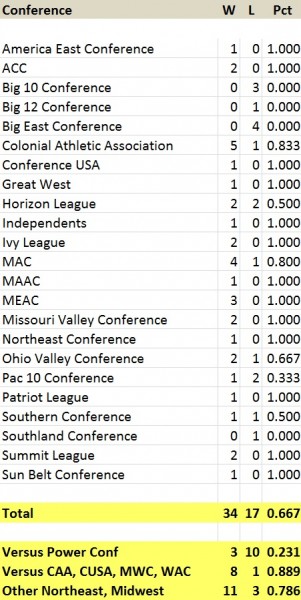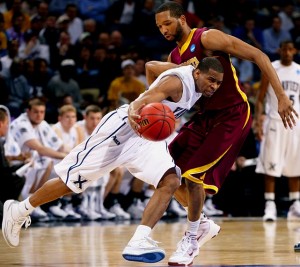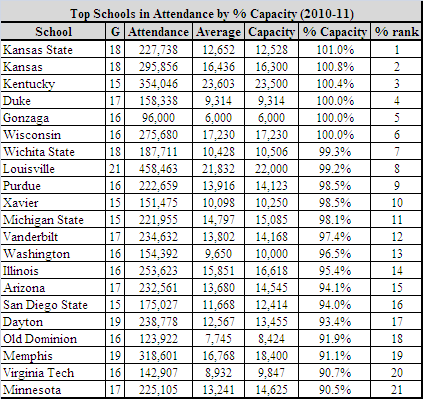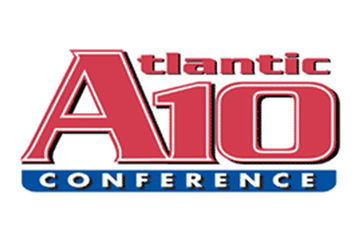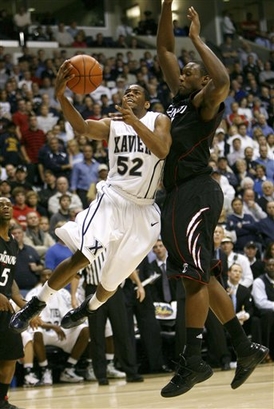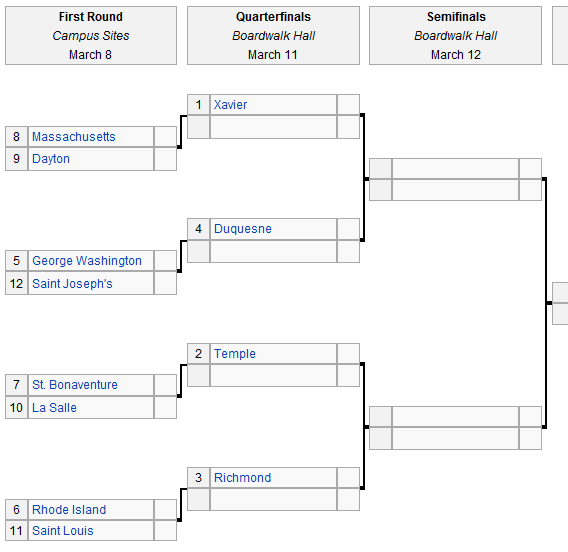
Joe Dzuback of Villanova by the Numbers is the RTC correspondent for the Atlantic 10.
A Look Back
Duquesne, despite an 0-2 week, continues to be ranked #2 in net efficiencies through Monday of this week (2/28/2011). Duquesne dropped into a fourth-place tie with Rhode Island after they sustained losses to the Rams and Saint Louis last week. While they have dominated enough games that their decline in net efficiency has not matched the decline in their won-loss record, it is clear the Dukes are suffering a severe end of the season slump. Bad timing, as a few of the conference teams need to finish their schedules strongly to earn bye seeds to Atlantic City, or at least secure home court advantage for the first round of conference tournament play. Xavier, Temple, Duquesne and Richmond, all of whom have maintained positive net efficiencies through the entire conference slate, were joined this week by a revitalized Dayton squad.
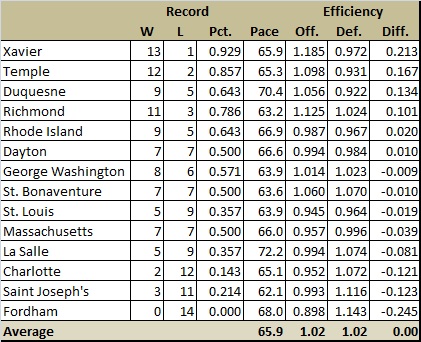
An oddity noted the past several weeks, but present through much of the A-10 conference regular season, is the inbalance between the teams with positive net efficiencies and those with negative net efficiencies, narrowed yet again when Dayton “crossed over” and joined Rhode Island on the plus side of net efficiency line. The gap between the “haves” and “have nots” has narrowed, as well, with the range between the top (Rhode Island with +0.020) of the middle four schools in the conference and the bottom (Saint Louis -0.019) is only 0.039, a gap less than that which separates Xavier from Temple (0.046) and less than a third of the gap which separates Fordham from Saint Joseph’s (0.122). I speculated last week about whether the relatively “bottom-heavy” conference would hurt Richmond’s chances for an NCAA berth, and it now appears as if that was premature as both Bracketology 101 (best predictive record over the past five seasons) and Joe Lunardi over at ESPN have Richmond in their field of 68. RTC bracketologist Zach Hayes lists the Spiders among the “first four out” in his February 28 bracket.
For those who wonder what happened to their team in conference play, the grid below should be helpful. The average efficiency for the conference is 1.018 (or 101.8 points per 100 possessions) — conference games only. By comparing each team’s offensive and defensive efficiency to the conference average (average for all conference games), I was able to determine whether the team had a “better than average” offense or defense (or both or neither). The grid below confirms the narrative of the conference season…
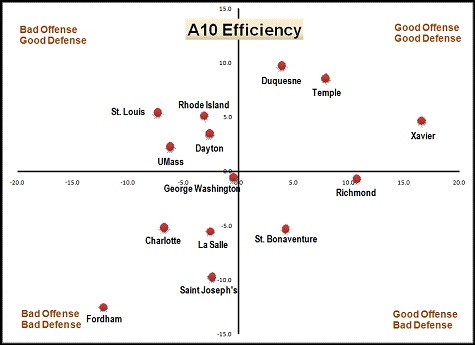
…with a few twists and insights. While two of the three “Good/Good” teams, Xavier and Temple, are entirely predictable, those who wonder why Richmond, despite preseason predictions, has struggled to secure their place in the NCAAs, the answer (from the chart) suggests it may have to do with defense. The Spiders have provided enough offense, but have struggled defensively in several conference games this season (Xavier, Temple and at George Washington). Through 14 conference games the Spiders are ranked #10 in shot defense (eFG%) and #9 in defensive rebounding, two factors that hurt when matching up with Xavier and Temple in particular. The key to the Bonnies revival this season is offense, while Rhode Island’s late season resugence has come through defense. The oddest team on the grid is George Washington. The Colonials tout an 8-6 record through 14 conference games, yet register below average (“Bad/Bad”) in both offensive and defensive efficiency. The paradox is resolved by noting that Coach Hobbs’ club as won a number of close conference games, two with La Salle (72-67 & 82-80), versus Saint Louis (52-46) and at Charlotte (73-67) for example, while also losing by double digits to Temple (41-57), at Duquesne (59-84) and at Richmond (58-68). Consistency matters too, it seems.
Power Rankings
The top team is Xavier. The Muskies settled it on the floor of the Consol Arena Sunday with a comfortable win over Duquesne, who dropped to #4 in the conference “record rankings.” Oddly, the bottom spot was also settled on the court, on Sunday and also with the host taking the loss. Saint Joseph‘s will now battle with Charlotte for the last spot in the first round of the A-10 Conference Tournament. Rhode Island also had a good week, while Dayton did not. Those developments are also reflected in the conference rankings and this week’s power rankings.
1. Xavier (22-6, 13-1) #23 AP
Last Week: 2/27 @Dayton 66-62
Next Week: 3/2 vs. Charlotte, 3/5 @St. Louis
Xavier continues to roll, pushing Dayton away 66-62 in a late season game that has become a conference television event. Tu Holloway again posted game-high points, 26 this time, as the Musketeers completed their sweep of the Flyers. The X-men moved up to #23 in the latest AP poll (Monday 2/28). In retrospect, the late season road game at Georgia was a very smart scheduling move. Coach Chris Mack‘s squad has games against Charlotte and a visit to Saint Louis to finish the week. Should Xavier drop both games, the #1 seed in Atlantic City would most likely go to Temple. Given the 49ers and Billikens have a combined 7-21 conference record however, those chances are pretty small (a quick log5 calculation puts the probabilities of winning both games at 70% — very, very likely). Go 1-1 and Xavier will still take the #1 seed by virtue of their holding the tie breaker over Temple. For a team that looked like their season was over on January 6, Xavier’s comeback is remarkable and a tribute to the coaching staff and players.
2. Temple (22-6, 12-2)
Last Week: 2/23 @Duke 61-78, 2/26 @George Washington 57-41
Next Week: 3/2 @Massachusetts, 3/5 vs. La Salle
A 1-1 week with a 17-point loss at Duke was the lowlight to Temple’s next-to-last week of the regular season play. Lavoy Allen took his second Player of the Week citation from the conference. The Owls are adjusting to life without Michael Eric. Temple has two conference games this week. They travel to Massachusetts for a game with the Minutemen on Wednesday, then back home for the regular season closer with Big 5 rival La Salle. A 2-0 week is very probable (the log5 probability per Ken Pomeroy is 78.9%, very likely). The Owls own the tie-breaker over Richmond, so a 1-1 week most likely still earns them the #2 seed in the Atlantic 10 Tournament.
3. Duquesne (17-10, 9-5)
Last Week: 2/23 vs. Rhode Island 76-77, 2/26 @St. Louis 51-62
Next Week: 3/2 vs. St. Bonaventure, 3/5 @Richmond
The Dukes ran their losing streak to three through the games of last week. After an 8-0 start to conference play, Duquesne has logged a 1-5 record in conference play. Talk of an NCAA bid (remote short of an outstanding record — 14 or more wins for example — in conference play), vanished with their loss to Xavier on February 13, the Dukes nevertheless hold a #3 in the NIT field per The Bracket Project and an #8 seed per John Templon’s computer projection. Templon’s #8 seed puts the Dukes on the NIT bubble, something that could be addressed with at least one win in games of the last week of conference play. Ron Everhart and the Dukes host the Bonnies on Wednesday, then take to the road to close out the regular season in Richmond on Saturday. The Dukes have lost out on the last bye seed in Atlantic 10 Tournament, but even if they log another 0-2 week (not probable) they will host a first round A-10 Tournament game. No question Duquesne fans have to be disappointed with the team’s play over the last six games (a -0.020 net efficiency and 0.440 Pythagorean Winning Percentage), the good news is wins away from the Palumbo this season. The 2010 Dukes logged a 3-8 (0.273) record in away and neutral games that included a net efficiency of -0.102. This season Duquesne has a 0.093 net efficiency reflected in their 8-7 (0.533) record.
4. Richmond (22-7, 11-3)
Last Week: 2/26 @Charlotte 72-59
Next Week: 3/2 @Saint Joseph’s, 3/5 vs. Duquesne
Richmond closed their series with Charlotte with a 13 point road win. The Spiders have locked down at least a #4 seed in Atlantic City, bypassing the first round game for the second consecutive season, irrespective of how they play against Duquesne. A worst case for Coach Mooney’s team is an 0-2 week with a corresponding 2-0 from Rhode Island, in which case the Runnin’ Rams would take the #3 seed and push the Spiders down to a #4 seed (with a semi-final game versus Xavier, should both survive the quarter final round on Friday). A relatively unlikely possibility however, since the Spiders have a two loss edge over Rhode Island and play 3-11 Saint Joseph’s on Wednesday, a game Pomeroy projects as a win to a 80% probability. While Richmond has had some inconvenient timing with home games this season (Bucknell, Rhode Island and Xavier ring a bell?) and the Dukes have improved away from Palumbo this season, the Spiders have to be favored to close out the regular season with a win and a 13-3 conference record because Richmond is a consensus bubble team for the NCAAs right now, and finishing with a good run can only help their chances. Bracketology 101 has Richmond in as an #11 seed (last eight in territory), while RTC’s Zach Hayes has Richmond (just barely) out.
5. Rhode Island (18-10, 9-5)
Last Week: 2/23 @Duquesne 77-76, 2/26 @Fordham 90-58
Next Week: 3/2 vs. George Washington, 3/5 @St. Bonaventure
Rhode Island logged a 2-0 week to bounce back yet again and leapfrog the Flyers in my power ranking. The road win over slumping Duquesne gives Jim Barron‘s team the tie-breaker over the Dukes — both share #4 in the conference standings through March 1. Fourth place is the last bye seed in Atlantic City, and would allow the Runnin’ Rams to rest through the front end of next week, when eight of the conference’s 14 teams will go head-to-head one last time to decide who goes on to spend the weekend in Atlantic City, NJ. Rhodi’s last two will not be easy, hosting George Washington on Wednesday and traveling to St. Bonaventure on Saturday. Both the Bonnies and Colonials have improved with more season play. Sweep and Rhode Island has the last bye seed irrespective of other outcomes. Lose one or (horrors…) both, and final standings get complicated. Though an NCAA invitation will only come should the Runnin’ Rams run the table in Atlantic City, they are very much in play for an NIT berth, currently seeded #8 in both The NIT Bracket Project and John Templon’s computerized projection Rhode Island is on the (NIT) bubble, but a second 20 win season and strong finish in conference play should secure them a place in the field of 32.
6. Dayton (19-10, 7-7)
Last Week: 2/27 vs. Xavier 62-66
Next Week: 3/2 vs. Saint Louis, 3/5 @George Washington
Dayton logged an 0-1 week and dropped back to a 0.500 record in conference play. The Flyers, currently in a three-way tie for #7 (Massachusetts holds the tie-breaker), have an opportunity to move up to sole possession of #6 if they can beat both Saint Louis and George Washington to close out conference play. The Colonials have not been dominant at home during conference play (a 0.013 net efficiency for their seven conference home games), but the Flyers have been something less than Road Warriors themselves, logging an anemic -0.018 net efficiency in seven conference road games. Pomeroy’s log5 projection narrowly gives the game to the Flyers.
7. George Washington (15-13, 8-6)
Last Week: 2/23 vs. Charlotte 74-57, 2/26 vs. Temple 41-57
Next Week: 3/2 @Rhode Island, 3/5 vs. Dayton
The Colonials beat Charlotte on Wednesday, but lost (predictably) to Temple Saturday. This last week could be a Statement Week for Coach Karl Hobbs’ squad. Both games are with NIT teams from 2010, and teams close to the sixth ranked (in conference standings) Colonials. Take both and GW has assured themselves of home court advantage for the first round of conference play. Lose both and GWU closes the regular season with a 0.500 records, both in conference (8-8) and overall (15-15).
8. St. Bonaventure (15-12, 7-7)
Last Week: 2/23 vs. Fordham 82-63, 2/26 @Saint Joseph’s 65-79
Next Week: 3/2 @Duquesne, 3/5 vs. Rhode Island
Coach Mike Schmidt’s Bonnies thumped Fordham, but lost by 14 to struggling Saint Joseph’s. Though finishing the regular season above 0.500 and assuring themselves of at least a first round game in the Atlantic 10 Tournament has to be gratifying, locking down a homecourt advantage for the tournament has been squandered with the Saint Joseph’s loss. The last two games are interesting because both Duquesne and Rhode Island are tied for #4 in the conference standings and in the conversation for an NIT berth. Win both and the Bonnies will most likely tie for #6 in the conference standings and grab the #7 seed (and home court advantage) for the first round of the A-10 tournament (and play St. Louis). Win neither and St. Bonaventure will do no worse than last season’s 7-9, a #9 seed and trip to Washington DC for a first round tournament game at George Washington.
9. Massachusetts (15-12, 7-7)
Last Week: 2/23 vs. Saint Joseph’s 69-51, 2/27 @La Salle 49-72
Next Week: 3/2 vs. Temple, 3/5 @Fordham
The Minutemen posted another 1-1 week, beating Saint Joseph’s by two and dropping a 130point decision on the road to La Salle. Best case scenario for Derek Kellogg‘s squad is a 9-7 finish and a #6 place tie with Dayton. UMass holds the tie-breaker, which would give the Minutemen the home court for a first round game versus Saint Louis, a team they lost to during the season. A more likely 1-1 week would probably put UMass in tie for #7, good for the #8 seed and a first round game (at home) versus (most likely) St. Bonaventure.
10. La Salle (13-16, 5-9)
Last Week: 2/27 vs. Massachusetts 72-49
Next Week: 3/2 vs. Fordham, 3/5 @Temple
The Explorers logged a 1-0 week, beating Massachusetts in convincing. The losing streak stops at three games. Best finish for the Explorers at this point would give them a win over Big 5 rival Temple (and level their season series at 1 apiece) and a #10 seed for the A-10 tournament. Dr. Giannini’s squad would most likely travel to Massachusetts for a first round game with the Minutemen, a team that beat them by 23 last week. A more likely scenario has La Salle finishing conference play with a 6-10 record, but still with a claim to the #10 seed in the tournament.
11. Saint Louis (11-17, 5-9)
Last Week: 2/26 vs. Duquesne 62-51
Next Week: 3/2 @Dayton, 3/5 vs. Xavier
The Billikens posted a 1-0 week, complements of an 11 point win over fading Duquesne and a Rookie of the Week effort from Dwayne Evans. Finishing out with Dayton and Xavier is a tough road for Rick Majerus‘ charges. No doubt the schedule-makers anticipated a Mitchell and Reed-led team would challenge the Musketeers and Flyers for a piece of the conference elite. The late season games should be a valuable experience for the freshmen and sophomore-heavy team. Something they can build on for next season. Worst case, the Bills drop both and draw the #11 seed for the A-10 Conference Tournament. They will most likely travel to Dayton or Duquesne for a first-round tournament game.
12. Charlotte (10-18, 2-12)
Last Week: 2/23 @George Washington 57-74, 2/26 vs. Richmond 59-72
Next Week: 3/2 @Xavier, 3/5 vs. Saint Joseph’s
Another 0-2 week has extended coach Alan Major‘s losing streak to six. Prospects to break the run at six are slim as Charlotte takes to the road for a game with Xavier Wednesday. Prospects are a bit better on Saturday, as the 49ers host Saint Joseph’s. The last ticket to the first round of conference tournament play is on the line.
13. Saint Joseph‘s (8-20, 3-11)
Last Week: 2/23 @Massachusetts 51-69, 2/26 vs. St. Bonaventure 79-65
Next Week: 3/2 vs. Richmond, 3/5 @Charlotte
The Hawks logged their second consecutive 20 loss season during the course of a 1-1 week. Langston Galloway earned his fourth Rookie of the Week citation (shared with Saint Louis forward Dwayne Evans). Looking ahead, beating Richmond, improbable (about a 20% probability per Ken Pomeroy), would nevertheless assure the Hawks of a first round game in the A-10 Tournament. Should they lose, their road game with Charlotte will decide who gets the last ticket to the A-10’s first round, and one last game for the season.
14. Fordham (6-20, 0-14)
Last Week: 2/23 @St. Bonaventure 63-82, 2/26 vs. Rhode Island 58-90
Next Week: 3/2 @La Salle, 3/5 vs. Massachusetts
Fordham’s winless string runs to 14 in conference play, with an 0-2 week. The probabilities (per Ken Pomeroy) have climbed to an ominous 59.9%. The Rams are staring at a two season winless run in conference.
A Look Ahead
No conference titles on the line this week, and in retrospect, it seems the schedule-makers in September overestimated Saint Louis and Dayton, while underestimating Rhode Island. Places #1 and #14, however, are the only two that are absolutely settled going into the last week of conference play. Virtually every other place will be settled by play either Wednesday or Saturday. The season will end Saturday for those teams finishing #13 and #14. At the bottom of the conference Saint Joseph’s and Charlotte will most likely settle who gets the last berth in the first round in Halton Arena, Charlotte Saturday.
The last A-10 Conference Tournament bye seed (#4) is still in play, with Rhode Island and Duquesne the primary candidates. Both will play St. Bonaventure this last week of the season, so the Bonnies, who have no hope of finishing higher than #7, can play the spoiler. Of particular interest is the Wednesday game between Duquesne and St. Bonaventure, to be played in Pittsburgh. The Bonnies beat the Dukes in Olean early last month, the loss that started the Dukes’ fall from grace. Places #5 through #10 will also be settled on the court this week, with Dayton, George Washington, St. Bonaventure, Massachusetts, along with Duquesne and Rhode Island all having a stake in the outcome. St. Bonaventure, Rhode Island and George Washington have games with two teams ranked in that group, several with each other (Rhode Island-St. Bonaventure, Rhode Island-GWU). Of interest is Dayton’s Saturday game with George Washington, as the winner will hold the tie-breaker over the other in the event Rhode Island loses to George Washington.






























